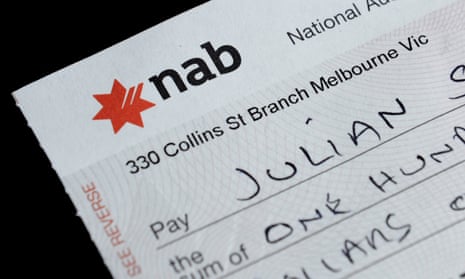The treasurer, Jim Chalmers, has signed the cheque’s death warrant to end its use in Australia by 2030, as part of a range of payment reforms for the digital era.
In a speech to be delivered to the Australian Banking Association in Sydney on Wednesday, Chalmers will say there has been a 90% decline in the use of cheques over the past 10 years alone but it remains a legacy payment method, while other economies have transitioned to digital payments.
Chalmers will say that 98% of personal cheques and 100% of those used in institutional and commercial settings could be serviced through internet or mobile banking, and that using cheques is a more costly way of doing business.
The government will now begin the process of winding down the use of cheques across the banking system, with federal departments to use other payment methods by 2028. A goal has been set to end the use of cheques completely in 2030.
“This transition will be gradual, coordinated and inclusive,” Chalmers will say. There will be public consultation on the transition, including with the states and territories, before the end of this year.
Sign up for Guardian Australia’s free morning and afternoon email newsletters for your daily news roundup
The decision comes as part of the government’s strategic plan for Australia’s payments system, released on Wednesday, which will set out a roadmap to modernise the country’s payment infrastructure and set it up for the future.
“Payments are the tracks on which our economy runs,” Chalmers will say, “which means that improvements here make everything move more efficiently, reducing costs for households and businesses, freeing up resources that can be used to grow the economy.”
The roadmap outlines five areas for reform, much of which were covered off in the May budget under separate initiatives, including:
after newsletter promotion
Resiliency and security of payment infrastructure, including reducing scams and boosting cybersecurity.
Modernisation, including phasing out cheques and transitioning from the old clearing system to the new payments platform.
Technology advancements including digital ID, consumer data rights, and an already announced consultation on AI.
Piloting a central bank digital currency and becoming a leader in global payments through the G20 and the Pacific.
Improving payment system transparency and collaboration between agencies, as well as consultation on the Reserve Bank’s mandate.
“Our vision is to create a modern, world-class and efficient payments system that is safe, trusted, and accessible, and enables greater competition, innovation and productivity across the economy,” Chalmers will say.
Despite the shift to digital payments, the government has said it is committed to keeping Australians able to access cash, and said it will support banking at Australia Post and plans to respond to a Senate inquiry on bank closures in December 2023.
